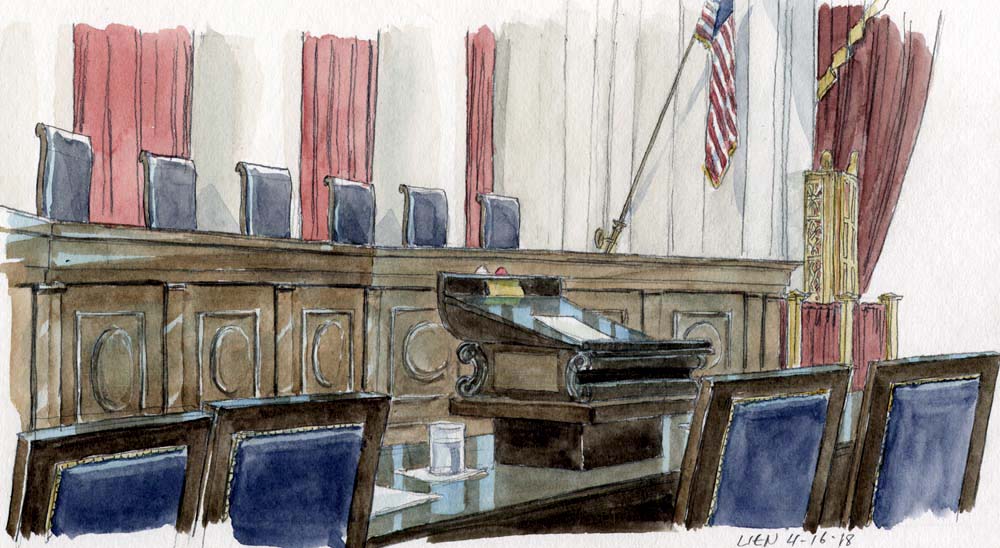A “view” from my laptop: Arguments.com

on May 4, 2020 at 4:29 pm

There is much anticipation going into this morning’s argument, historic for being conducted via teleconference because of pandemic concerns and for offering live audio for the first time. On C-SPAN in the hour before the argument, Jeffrey Rosen, the president of the National Constitution Center, is giddy with excitement.
“It is indeed a historic morning,” says Rosen. “It’s an experiment for everyone.”
The lawyers arguing this morning’s case, U.S. Patent and Trademark Office v. Booking.com B.V., are Erica Ross, an assistant to the solicitor general, for the PTO, and Lisa Blatt, for the internet travel website that was denied a trademark for its name.
News reports indicate that Ross is arguing from the solicitor general’s office at the Department of Justice, while Blatt is at her home in Washington. As detailed in The Washington Post last week, Blatt has fashioned a lectern on top of her dining room table to replicate the setting in the courtroom. She has also assigned one of her children to keep the family dog occupied during the call, and another “to intercept anyone who approaches the house,” Bob Barnes reported.
By 9:30 a.m., the two lawyers should have received a call from the court and been placed on hold well in advance of the scheduled 10 a.m. start of the argument. They are cooling their heels in a virtual version of the lawyers’ lounge in the Supreme Court building.
The “order of business” announced by the court originally set 9:15 a.m. as the time for that call, but it was amended to have Clerk of the Court Scott Harris deliver his last-minute instructions this past Friday for these experienced Supreme Court advocates. Seven of the 24 total advocates who will argue in this telephone sitting will be first-timers, according to Marcia Coyle at The National Law Journal.
The court also announced that the justices “will enter the main conference call” at 10 a.m., and that is what happens shortly after the top of the hour. As previously announced, Marshal of the Court Pamela Talkin brings some continuity to the proceedings with her traditional “cry.” But the script has been amended ever so slightly to reflect the times.
“Oyez! Oyez! Oyez!,” Talkin says, “All persons having business before the honorable, the Supreme Court of the United States are admonished to give their attention, for the court is now sitting. God save the United States and this honorable court.”
She bangs her gavel. She left out a few words from the normal cry, which is “to draw near and give their attention.” The court’s Public Information Office confirms that the change was made on purpose. Please don’t draw near, the court seems to say, but maintain proper social distancing.
The voice of Chief Justice John Roberts makes itself known as he calls the case. He does not mention, as he typically would in the courtroom, that today’s orders have been duly certified and filed with the clerk, and of course there are no bar admissions.
Ross gets two minutes of uninterrupted time to open her argument that adding a top-level domain name such as “.com” to a generic term does not make for a protectable trademark.
“It is a fundamental principle of trademark law that no party can obtain a trademark for a generic term like ‘wine,’ ‘cotton,’ or ‘grain,’” she says. “It is undisputed that ‘booking’ is generic for the hotel reservation services that respondent provides. Respondent thus could not federally register ‘Booking.’”
There has been much discussion about how another of the court’s orders of business for these telephone arguments—asking questions by seniority—will change the normal dynamic in the court’s typical free-for-alls on the bench. There has also been worried speculation about a lack of follow-up questions. The justices will soon show they have some tricks up their sleeves.
The chief justice interrupts Ross with a question about the government’s reliance on an 1888 case involving the Goodyear Rubber Co. He asks her a follow-up, setting a precedent that his colleagues are only too happy to observe.
Next up is the normally reticent Justice Clarence Thomas. “Yes, Ms. Ross. … A couple of questions.” Twitter starts lighting up at the first oral argument question from Thomas in more than a year.
Roberts cuts off Ross’ answer to Thomas’ second question, something the chief justice will do throughout the morning to try to keep things moving.
Justice Ruth Bader Ginsburg is next, and she quickly follows precedent. “Two questions,” she says.
“If you’re right that ‘.com’ doesn’t make a generic term non-generic, how many marks, already registered marks, would be subject to cancellation?” Ginsburg asks, referring to an argument Blatt has made in her brief for Booking.com that the government’s rule would likely bar trademarks for a generic term paired with “store” or a synonym, thus putting such current marks as The Container Store and the Cheesecake Factory at risk.
Ross tries to answer Ginsburg by saying that the Cheesecake Factory “is not a literal factory producing cheesecakes. It’s a restaurant.” (Has she been to one? Ah, I kid. I love the Godiva® Chocolate Cheesecake. And yes, the restaurant includes the registered trademark symbol on the menu.)
Including her follow-ups, Ginsburg asks four questions. Justice Stephen Breyer prefaces his lone question to Ross with a “good morning.” Several other justices will also say that, which they would never say in the courtroom.
Justice Samuel Alito isn’t one of them. He dives right into his question. After a lengthy answer by Ross, the chief justice calls on Justice Sonia Sotomayor. There is a silent pause.
“Justice Sotomayor?” Roberts says again. It appears she may be stuck on mute.
“I’m sorry, chief,” she says. It sounds genuine, and not the #SorryNotSorry tone with which she often interrupts an advocate by saying “I’m sorry …”
By the time we have gotten through questions to Ross from Justices Neil Gorsuch and Brett Kavanaugh, we’re a good five minutes past the usual half hour devoted to the petitioner’s side.
The process is repeated for Blatt. When Ginsburg asks her when a generic term plus “.com” might remain ineligible for a trademark, Blatt has a timely example that probably had not occurred to her when she filed her merits brief on Feb. 12.
One example “is that sometimes people think of generic word .coms generically,” Blatt says. “I have searched every grocerystore.com looking for toilet paper. I have now started looking at every hardware.com. I am using fooddelivery.com for all of my takeouts these days. Those are generic usages of a generic word .com.”
For this first telephone argument that some observers feared involved the inscrutable and complicated world of trademark registration, the references are at least providing some light moments.
Alito suggests that “Booking Company” would not likely get trademark protection, “but because of the Internet, you have Booking.com, which gives you an advantage over other companies that are in that business. And now you want to get even more advantage by getting trademark protection for that.”
“This is just not true,” Blatt says. “The Wig Company, which is registered, is celebrating its 50th year anniversary. It’s called The Wig Company. There’s also The Wig Shop and The Wig Store and The Wig Mart. And so it’s not like Wig Company has crowded out wig companies.”
Some teachers were planning to assign their students to listen to these historic telephone arguments. One can imagine some puzzlement at the dinner table this evening if parents ask their children what they learned from the argument, and the reply is, “Well, they talked about wine and cheesecake and wigs.”
Ross gets three minutes for rebuttal, followed by the chief justice saying, as he would under normal circumstances, “Thank you, counsel. The case is submitted.”
The end time is 11:16 a.m., which is a bit behind schedule. But, by and large, the experiment is a success.


